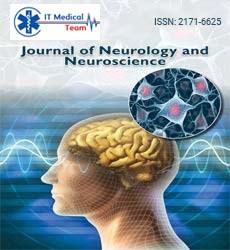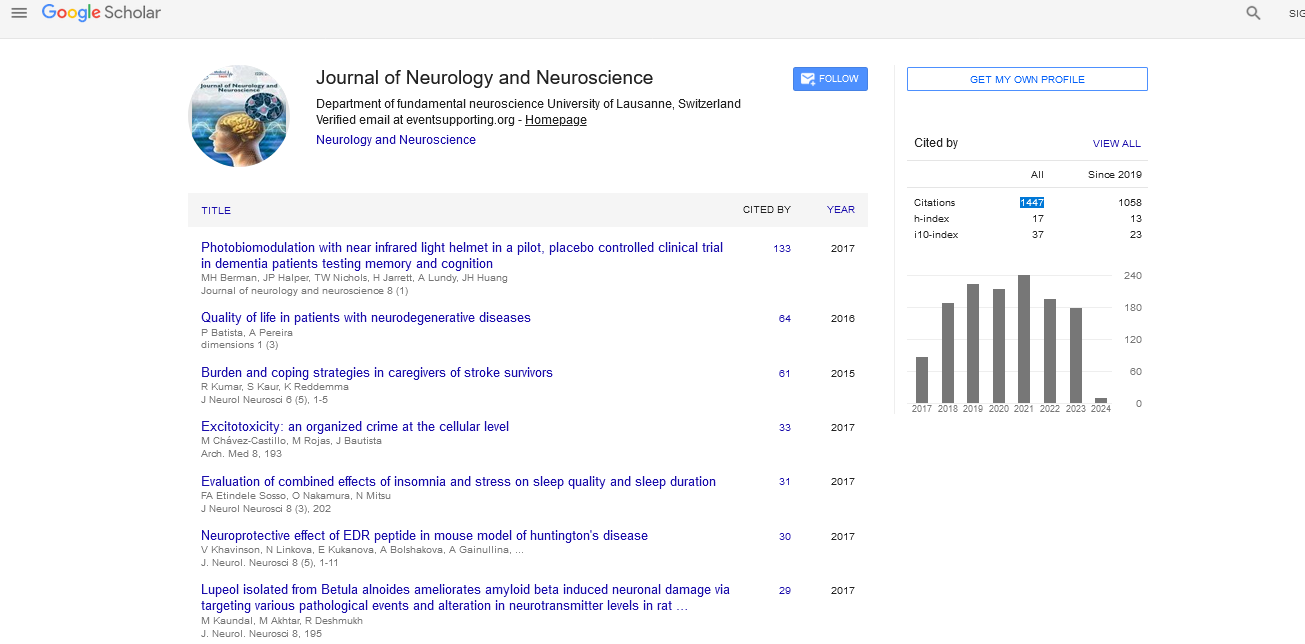Commentary - (2024) Volume 15, Issue 5
Innovations in neuroanatomical mapping tools for the modern neuroscientist
Ewa Ziołkowska*
Department of Pediatrics, Washington University School of Medicine, St. Louis, MO 63110, USA
*Correspondence:
Ewa Ziołkowska, Department of Pediatrics, Washington University School of Medicine, St. Louis, MO 63110,
USA,
Email:
Received: 03-Oct-2024, Manuscript No. ipjnn-24-15389;
Editor assigned: 05-Oct-2024, Pre QC No. P-15389;
Reviewed: 18-Oct-2024, QC No. Q-15389;
Revised: 24-Oct-2024, Manuscript No. R-15389;
Published:
31-Oct-2024
Introduction
The field of neuroscience is experiencing a remarkable
evolution, driven by rapid advancements in technology
and a deeper understanding of brain structure and
function. One of the most significant developments in
recent years has been in neuroanatomical mapping tools.
These innovations not only enhance our understanding
of brain architecture but also improve the precision of
neurological research and clinical practices. This article
explores the latest advancements in neuroanatomical
mapping tools, their applications, and their implications
for modern neuroscience. Neuroanatomical mapping
refers to the techniques used to visualize and understand
the organization of the nervous system. Mapping helps
identify regions responsible for specific functions,
facilitating a deeper understanding of how different areas
of the brain interact. Accurate brain mapping is essential
for diagnosing and treating neurological disorders, guiding
surgical interventions, and developing targeted therapies.
Neuroanatomical mapping supports the investigation
of complex neurological phenomena, including
neuroplasticity, neurodevelopment, and the impact of
diseases on brain structure [1].
Historically, neuroanatomical mapping relied on
traditional techniques such as histology, MRI, and PET
scans. While these methods provided valuable insights,
they had limitations in resolution, specificity, and dynamic
observation. For instance, histological techniques, although
excellent for detailed cellular analysis, are destructive
and provide a static view of brain structure. Similarly,
MRI and PET scans, while non-invasive, often lack the
spatial resolution necessary to discern finer anatomical
details. One of the most notable advancements in imaging
technology is the introduction of 7 Tesla (7T) MRI
scanners. Unlike traditional 1.5T or 3T scanners, the
7T MRI provides significantly higher resolution images,
allowing for the visualization of smaller structures and finer
anatomical details within the brain. This advancement is
crucial for identifying subtle changes in brain anatomy that
may be associated with neurological disorders. Diffusion
Tensor Imaging is an advanced form of MRI that maps the
diffusion of water molecules in brain tissue [2].
Description
SBFSEM is an innovative technique that allows
researchers to visualize the brain’s microstructure in three
dimensions. By slicing the brain into thin sections and imaging each slice, SBFSEM provides an unparalleled
view of cellular architecture. This method is particularly
valuable for studying the connectivity of neurons and the
organization of brain circuits. The CLARITY technique
involves making brain tissue transparent while preserving
its molecular composition. This allows researchers to
visualize complex neural networks in intact tissue,
facilitating a better understanding of how different
brain regions interact. Other transparency methods, like
iDISCO, are also emerging, allowing for high-resolution
imaging of neural circuits without the need for extensive
sectioning [3].
The integration of Machine Learning (ML) and
Artificial Intelligence (AI) in neuroanatomical mapping
tools is revolutionizing data analysis. These technologies
enable the processing of vast amounts of imaging data,
enhancing the accuracy and speed of neuroanatomical
studies. Automated segmentation algorithms can identify
and delineate different brain structures in imaging data,
reducing the time and potential biases associated with
manual analysis. These algorithms are particularly useful
in large-scale studies where consistency and reliability
are paramount. AI-driven predictive modeling can help
identify patterns in brain structure that correlate with
specific behavioral outcomes or disease states. This
capability enhances our understanding of the relationship
between brain anatomy and function, providing insights
that were previously unattainable [4].
As neuroanatomical mapping tools become more
advanced, the amount of data generated is increasing
exponentially. Neuroinformatics platforms are emerging to
facilitate the organization, sharing, and analysis of this data.
The Human Connectome Project aims to map the brain’s
neural connections in detail, providing researchers with a
comprehensive resource for studying brain connectivity.
This project exemplifies the importance of collaborative
data sharing in advancing neuroanatomical mapping.
Open data initiatives are gaining traction in
neuroscience, encouraging researchers to share their
neuroanatomical data and findings. This collaborative
approach fosters innovation, accelerates research, and
enhances the reproducibility of studies. The advent
of Virtual Reality (VR) and Augmented Reality (AR)
technologies is transforming how researchers and
clinicians visualize and interact with neuroanatomical
data. VR allows for immersive exploration of brain
structures, enabling researchers to visualize complex
datasets in three dimensions. This capability enhances
spatial understanding and facilitates the interpretation of
intricate neuroanatomical relationships. AR can overlay
neuroanatomical information onto the surgeon's field
of view during procedures, enhancing surgical precision
and safety. Additionally, AR technologies are being used
in educational settings to teach neuroanatomy, providing
interactive experiences that deepen understanding [5].
The innovations in neuroanatomical mapping tools
have far-reaching implications for both clinical and
research settings. Advanced mapping techniques are being
utilized to study various neurological disorders, such as
Alzheimer’s disease, Parkinson’s disease, and schizophrenia.
By examining changes in brain structure and connectivity,
researchers can identify biomarkers for early diagnosis and
develop targeted treatments. Understanding the developing
brain is critical for identifying atypical neurodevelopmental
trajectories. Advanced mapping tools enable researchers to
investigate the dynamic changes in brain structure during
key developmental periods, informing interventions
for conditions such as autism spectrum disorder.
Neuroplasticity, the brain’s ability to adapt and reorganize
itself, is a central topic in neuroscience. Enhanced mapping
techniques allow for the examination of structural changes
associated with learning, recovery from injury, and other
experiences that shape brain function.
Combining different imaging modalities, such as
MRI, PET, and electrophysiological data, will provide a
more comprehensive understanding of brain function.
Multimodal approaches can reveal correlations between
brain structure, connectivity, and activity, enriching our
understanding of complex neural phenomena. As AI
technologies advance, their application in neuroanatomical
mapping will become increasingly sophisticated. Improved
algorithms for image analysis, predictive modeling, and
personalized medicine will enhance our ability to interpret
neuroanatomical data. Future innovations will likely
focus on developing tools that are more patient-centric,
enabling personalized treatment plans based on individual
neuroanatomical profiles. This approach could lead to
significant advancements in precision medicine within
neurology.
Conclusion
The innovations in neuroanatomical mapping
tools represent a significant leap forward for modern
neuroscience. These advancements not only enhance our
understanding of brain structure and function but also hold
the potential to transform clinical practice and research
methodologies. As technologies continue to evolve, the
possibilities for unraveling the complexities of the brain
are boundless. The integration of high-resolution imaging,
advanced histological techniques, machine learning, and
immersive technologies will undoubtedly lead to new
discoveries and breakthroughs in our understanding of the
nervous system. For the modern neuroscientist, embracing
these innovations is essential for pushing the boundaries of
knowledge and improving outcomes for individuals with
neurological disorders.
Acknowledgement
None.
Conflict of Interest
None.
References
- Yuval-Greenberg S, Tomer O, Keren AS, et al. Transient induced gamma-band response in EEG as a manifestation of miniature saccades. Neuron. 2008; 58(3):429-41.
Google Scholar, Crossref, Indexed at
- Oldfield RC. The assessment and analysis of handedness: The Edinburgh inventory. Neuropsychologia. 1971; 9(1):97-113.
Google Scholar, Crossref, Indexed at
- Zheng P, Zeng B, Zhou C, et al. Gut microbiome remodeling induces depressive-like behaviors through a pathway mediated by the host’s metabolism. Mol psychiatry. 2016; 21(6):786-96.
Google Scholar, Crossref, Indexed at
- Tang N. Exosomes in multiple sclerosis and Alzheimer's disease–Adversary and ally. Biomed J. 2024; 47(5):100665.
Google Scholar, Crossref, Indexed at
- Zott B, Konnerth A. Impairments of glutamatergic synaptic transmission in Alzheimer’s disease. Semin Cell Dev Biol 2023; 139: 24-34.
Google Scholar, Crossref, Indexed at





